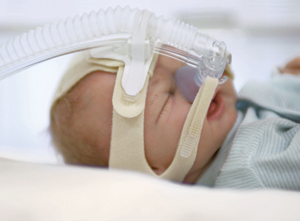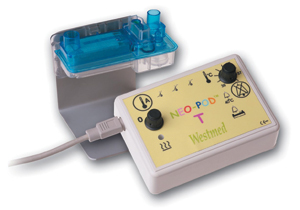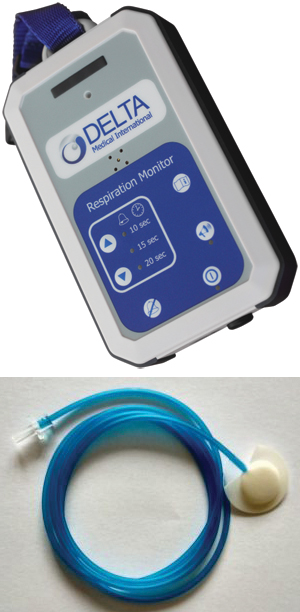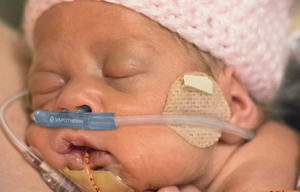Respiration: a guide to the latest equipment
Neonatal respiratory conditions are one of the most common reasons for admission to a neonatal unit. A preterm baby, or one born at term with a medical condition, may struggle to breathe by itself and need support from a ventilator, continuous positive airway pressure (CPAP) or a high-flow nasal cannula (HFNC) that delivers heated and humidified air to the baby’s lungs. Various monitors are used to measure the baby’s heart rate, breathing and oxygen in the baby’s blood. In this issue of Infant we examine recent innovations in medical equipment to support newborn respiration.
Reducing work of breathing with Infant Flow Low Pressure nCPAP
Sometimes HFNC might not be best for neonatal patients. The perfect CPAP should keep airway pressure as constant as possible to reduce work of breathing (WOB), as any deviations in pressure add to the WOB performed by the patient.

To help neonates to not have to work so hard, the Infant Flow Low Pressure (LP) interface from Aquilant delivers a constant CPAP level with low WOB. The patented Infant Flow LP nCPAP system features a dual-jet generator that incorporates fluidic technology. The low momentum impinging jets effectively reduce the patient’s WOB during inspiration and reduce resistance to expiratory efforts. The low pressure refers to the driving pressure.
Infant Flow LP’s vortices technology reduces the WOB on inhalation by meeting the patient’s inspiratory flow demand, while during exhalation the gas flow flips away from the patient, which in turn reduces resistance and therefore reduces the effort for the infant. This exchange is referred to as the ‘fluidic flip’. During inhalation, the dual jets entrain flow to meet the patient’s inspiratory demand, however during exhalation, the jets easily deflect to disrupt the gas flow in the direction of expiratory limb.
Compared with the legacy Infant Flow generator, the new Infant Flow LP generator significantly reduces the WOB by up to 70% in triggered BiPhasic mode. Additionally, during the first 100ms of inspiration, the Infant Flow LP generator reaches between 33% and 40% of the peak pressure compared with 11-20% for the previous generation.
Infant Flow LP is available from Aquilant.
Prevent dry airways during neonatal transport with Neo-Pod T
The Neo-Pod T maintains proper conditioning of inspiratory gas during transport to help maintain an infant’s neutral thermal environment and prevent inspissation of airway secretions. Adequate inspired gas temperatures are associated with a lower incidence of pneumothorax and a decreased severity of chronic lung disease in ventilated very low birth weight infants. Mechanical ventilation during transport, even bagging, without humidification, can result in heat loss through the lungs, making thermoregulation more difficult.

Now with an improved LavaBed humidifier cartridge, the Neo-Pod T is the first disposable active humidification device designed to operate with virtually all ventilation/incubation systems used in neonatal transport including mechanical ventilation, HFNC and CPAP therapy.
Neo-Pod T is available from Central Medical Supplies
Delta Medical’s RM15 enables immediate detection of apnoeic events
Respiration monitoring for the detection of apnoea in neonates is accepted practice in the UK, standard care for patients considered at risk, and part of the Care of Next Infant (CONI) programme developed by the Lullaby Trust. Respiration monitoring has the advantage that it gives immediate indication of apnoeic events, in contrast with pulse oximetry where detection only occurs once oxygen saturation has fallen.
Multi-parameter monitors used in a neonatal setting typically provide respiration monitoring, but they are over-sophisticated for patients who only need monitoring for apnoeic events and impractical where there is a need to monitor patients outside the hospital setting. Dedicated apnoea monitors provide an important step in reducing the medicalisation of patients and have a valuable and practical part to play in caring for neonates and young infants.

The most popular monitoring technology has used disposable pneumatic sensors, which are attached to the patient’s abdomen; the market was dominated by the Graseby MR10 until it was discontinued. The abdominal movement associated with respiration in babies and small infants presses against the sensor which generates small pressure changes that are detected by the monitor. The use of disposable sensors is favoured by most users not only for infection control reasons but also due to the elimination of problems with damage or loss. Other respiration sensor technologies have become available using piezo-electric technology. Although reuseable, these sensors are significantly more expensive than the pneumatic type and the monitors are not suitable for smaller babies under 1.5kg, who are typically those most at risk due to apnoea of prematurity.
The RM15 from Delta Medical International is a new apnoea monitor that uses a disposable sensor and can be used on babies under 1.5kg. RM15 uses the same pneumatic technology as the popular Graseby MR10. The product is British designed and manufactured, and has already proved popular with rapid uptake in the NHS.
Introducing Vapotherm high velocity therapy
Vapotherm high velocity therapy is an open system with a nasal cannula interface, which may be mistaken for just another high flow device. However, high velocity therapy is an advanced form of high flow that has been clinically proven as non-inferior to nasal CPAP (nCPAP) when it comes to primary respiratory support as well as post-extubation support.
While common HFNC uses large bore cannulas, Vapotherm high velocity therapy uses a small-bore cannula system which increases the velocity. This high velocity therapy flushes the upper airway dead space faster than common HFNC. It’s important for clinicians to understand how these two modalities differ in application and outcomes.

When treating newborn infants, some equipment may obscure their faces and require a tight seal against their fragile nose and face. Vapotherm’s new ProSoft cannula range is soft and simple; when used in combination with high velocity therapy, it is possible to deliver therapy for respiratory distress syndrome that is as effective as nCPAP and Bi-Level PAP. An alternative to nCPAP that provides primary respiratory support in the newborn with the gentleness of high flow.
nCPAP has been the gold-standard primary respiratory support. However, developmental care is crucial for premature neonates and skin-to-skin care and nursing can be challenging with nCPAP. Handling the baby creates a risk of leaking at the interface, which could compromise the efficacy of the therapy. The bulky interface hides a baby’s face from its family and could cause nasal trauma in this vulnerable population. With Vapotherm’s primary respiratory support, babies don’t have to miss out on family bonding and development. Mothers can breastfeed and families can practise skin-to-skin care without worrying about compromising the therapy by disrupting a pressure seal.
For more information on the products and companies discussed here, visit the Infant website Supplier Guide at www.infantjournal.co.uk/supplierguide.html
Or read this article in our
Tablet/iPad edition


